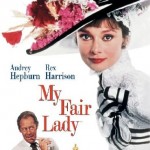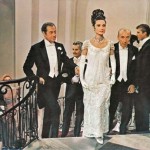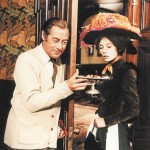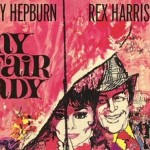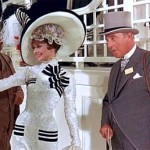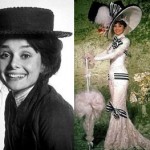As everyone surely knows, My Fair Lady is the Lerner and Loewe musical retelling for stage and later screen of Shaw’s Pygmalion, though stripped of some of Shaw’s more subtle social commentary in favour of entertainment value. While Shaw’s commentary adds much value, Lerner and Loewe did an excellent job adapting the story and adding some of the most memorable songs within living memory, and indeed director George Cukor in filming with poise and charm.
The plot is very familiar, so I hardly need describe it in detail. But if you’ve lived on Mars for the past 100 years, Eliza Dolittle is a flower girl encountered by linguist Prof. Henry Higgins, who for a bet with a professional colleague sets about training her to pass in society – starting with the elimination of her cockney accent and progressing to her clothes and behaviour. She succeeds, but rather than congratulating Eliza Higgins is chuffed to win his bet. Eliza exacts a revenge of sorts with help from Higgins’ mother, but the ending implies both that they are very mutually attached (“I’ve grown accustomed to her face”) and that in the final instance a misogynist will always remain thus.
There is much to admire in the movie, though let’s start with a few curiosities. Famously, Audrey Hepburn was cast for the role of Eliza Doolittle ahead of Julie Andrews, who had enjoyed a successful run in the stage production opposite Rex Harrison, possibly, you suspect, for the fragile waif-like quality effortlessly exuded by Ms Hepburn, but apparently not for her singing voice. The DVD of MFL includes test numbers sung by Audrey Hepburn, and to be fair her voice was not bad – just not as strong as Ms Andrews. Doolittle’s songs in the movie were therefore voiced over by the estimable Marni Nixon, the much heard but rarely seen queen of musicals. Nor was that the only voice overdub within My Fair Lady either. Jeremy Brett, who went on to find success playing Sherlock Holmes, among many other characters, had his songs as Freddy Eynsford-Hill sung by Bill Shirley – including my personal favourite On The Street Where You Live.
As cast and sung, there are gems to be seen everywhere in this all-star cast. Grumpy, misogynistic Rex Harrison is perfectly cast as the grumpy, misogynistic Higgins, to the extent that you suspect that is actually Harrison playing himself. Who could forget Stanley Holloway‘s proudly shambolic Alfred Doolittle (Holloway was in his 70s when this was filmed, but plays the role with the energy of a 40-year old), nor indeed his memorable delivery of With A Little Bit Of Luck and I’m Getting Married In The Morning? Then there is Wilfrid Hyde-White, Gladys Cooper and many more – almost all uncredited (including Ms Nixon!) In fact, wonderful characters and performers are constantly on screen – a joy to behold!
The look of the movie is also worthy of comment. During the first half, Victorian street scenes in Covent Garden and the working class areas of London are recreated in the studio, not perfectly but with a sense of proportion – the characters who populate it seem authentic and dressed to fit the bill. The ball scenes are splendid, perfectly matched for the occasion and designed to make Eliza stand out from the elegant crowd. But Cukor then chose to play the Ascot scene as a stylised grandiloquent fantasy, so far over the top that you suspect it to be a dream sequence. Designed by Cecil Beaton in pure and minimalist white with elaborate costumes and elaborate choreography, more akin to a square dance as the players sing the glorious Ascot Gavotte. The scene reeks of society protocol and thereby enhances the contrast to Higgins in his tweed suit and hacking hat, and of course to that wonderful line when Eliza in her excitement forgets her training and yells out, “Come on Dover, move yer arse!”
But the stars of this particular adaptation remain the songs. Apart from those listed above, there are the likes of Wouldn’t it be Lovely, The Rain in Spain, I Could Have Danced all Night, and a whole bunch more. The ratio of hits to duffers has never been better, possibly rivalled only by West Side Story and Cabaret. Quality tells in the long run, and this movie is unmistakably a quality product.


